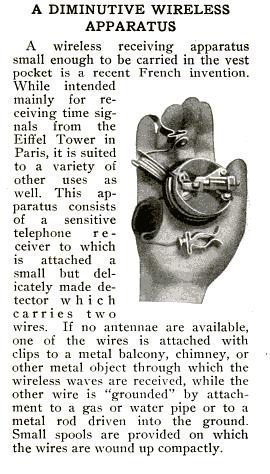 The April 1914 issue of Popular Mechanics includes this interesting portable zero-tube radio. It appears to be a crystal set consisting of a detector mounted directly to the headphone, with two wires for clipping to a convenient antenna and ground connection.
The April 1914 issue of Popular Mechanics includes this interesting portable zero-tube radio. It appears to be a crystal set consisting of a detector mounted directly to the headphone, with two wires for clipping to a convenient antenna and ground connection.
This particular receiver is billed as being for receiving time signals from the Eiffel Tower, which had begun on May 23, 1910. The station, FL, was operated by the French
Bureau des Longitudes, and transmitted time signals from the Paris Observatory. It operated on 2000 Meters (150 kHz) with a spark transmitter of about 40-50 kW. Service even continued during the war, which began for France about three months after this magazine was published.
Despite the apparent lack of any tuner, a crystal set such as this ought to have been able to receive the signal for quite a distance from Paris. As you can see, the two wires had clips for attaching to any suitable antenna and ground. The signal from the powerful station was so reliable that a guide to receiving the signals, published by the Bureau of Longitude in 1913, was translated and published in English in 1915. The translation is available to read at Google Books.
The original 1913 edition, Réception des signaux radiotélégraphiques transmis par la Tour Eiffel, is also available online.
Any doubts about whether a crystal set would be able to receive the powerful signal should be put to rest by the mere fact that this guide book was published in England. The guide states that the “energy radiated by the Eiffel Tower Station in transmitting signals is great enough to permit the use of receiving aerials of reduced height and dimensions throughout the whole of France and in the French possessions in North Africa.”
Station FL transmitted the exact time nightly at 11:45, 11:47, and 11:49 PM. And it seems quite likely that the little pocket receiver shown here would have been suitable for receiving it throughout much of France.
The Eiffel Tower time signals had the very practical purpose of an indispensable aid to navigation. There are many ways by which one can determine latitude. But longitude depends on knowing the exact time at a fixed location on Earth, and then comparing that to the local time. One early method of determining the exact time was by observing the moons of Juipter. Good chronometers largely solved the problem of having to go to these lengths, but there was still the matter of having to periodically set the chronometer. And time signals such as those provided by the Eiffel Tower greatly simplified the process. A pocket sized receiver such as the one shown here would have been a most useful accessory.

Pingback: 400 Foot Towers at Great Lakes, Illinois, 1915 | OneTubeRadio.com